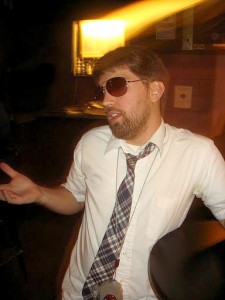About OhioFi.com
OhioFi.com is dedicated to music, technology, interactive art, project-based learning, gamification, art house films, electronics, La Nouvelle Vague, robots, multimedia, Arduino, the New Aesthetic, cross processing, 8-bit retro fun, LEDs, concert photography, circuit bending, pirates, music videos, retro-futurism, podcasts, indie pop, tinkering, vintage cameras, flipped learning, NPR, psychedelic freak-outs, ninjas, Ohio, synthesizers, lomography, minimalism, thrift stores, glitch, film noir, unicorns, and nothing else.
About The Author:
Mr. Riley is a swordsman, philosopher, strategist, writer and samurai. He is considered the Kensei, sword-saint of Japan. He likes to write code when he's not busy ninja-ing. He likes to make cool interactive web apps with Nodejs, WebSockets, jQuery, PHP, and MySQL. He has been coding since he started posting MIDI compositions on Geocities back in the 90s. He is currently teaching technology courses at several local educational institutions. He has a Bachelor of Music from Capital University, a Master of Science from Indiana University, and Miniature Schnauzer named Benny.
Summary of Mr. Riley's CV:
- 9-Time Academy Awards Watcher
- Geocities Certified Educator
- Antique File Collector
- Sword-saint of Japan
- Professional MIDI-ologist
- Invented the Number "Siftenteenth"
- Licensed Web Slinger (World-Wide)
Mission Statement:
Here at OhioFi.com, we are committed 24-7 to boldly following unquestionable e-management leadership by actualized performance and improved innovation. To put it concisely, we embrace collaborations, despite the fact that any pitch-class or performer can be, and has been interpreted as a rather contrastingly-apparent set of 'gesture-triads'. Discarding all principles, we are dedicated to supplying the full range of proactive optimization via customer satisfaction by support through functionality. The atonal consequences of juxtaposing arrangements enables the use of a single leitmotif amongst many fragmentary transformations.
Our efforts involve serving world-class investor returns by aquiring boat loads of profit in business opportunities at the highest level. We have found that post-predominant systems, in combination with psycho-Expressionist sonorities enable us to additively superimpose brand-new developments in a highly aesthetic and extremely resonant ways. That being said, ubiquitous synergy is always the key to delivering our clients a scalable "win-win" methodology. The iconic forms of any given dissonance must never clash with the ultimately flowing endeavour of visualising sounds wherever possible. By engaging in cultural recontextualising, OhioFi.com seeks to overcome the existing disparate models, and establish a more transdisiplinary and cognitive paradigm.
Frequently Asked Questions
If a tree falls in the forest and no one is around to hear it does it make a sound?
Sound is audible vibration. This simple definition implies the potential for inaudible vibrations, such as vibrations with an extremely high or low frequency (outside of the range of human hearing). Vibrations which have an extreme amplitude (or in layman's terms, volume level) of above 140dB could be described as inaudible because they could damage the ear and cause hearing loss. Finally, vibrations below the threshold of hearing would be inaudible. The threshold of hearing is generally reported as the RMS sound pressure of 20 µPa (micropascals) = 2×10−5 pascal (Pa). It is approximately the quietest sound a young human with undamaged hearing can detect at 1,000 Hz. The threshold of hearing is frequency dependent and it has been shown that the ear's sensitivity is best at frequencies between 1 kHz and 5 kHz. The vibrations created by a falling tree would be inaudible to "one" that was not "around." However, the question only postulates the absence of a human. The existence of hearing animals in a forest environment would be likely and therefore, the compressions and rarefactions of air would have been heard and would be defined as sound.
What is the air speed velocity of an unladen swallow?
The airspeed velocity of an unladen swallow is roughly 11 meters per second, or 24 miles per hour, beating its wings 7-9 times per second (rather than 43). This is based upon published species-wide averages of wing length and body mass, initial Strouhal estimates based on those averages and cross-species comparisons, the Lund wind tunnel study of birds flying at a range of speeds, and revised Strouhal numbers based on that study gives an estimate that the average cruising airspeed velocity of an unladen European Swallow is roughly 11 meters per second, or 24 miles per hour. That being said, it depends on whether you are talking about an African or European swallow.
How much wood would a woodchuck chuck if a woodchuck could chuck wood?
The amount of wood that woodchucks would chuck on a given day varies greatly with the individual woodchuck. According to a Wall Street Journal article, New York State wildlife expert Richard Thomas found that a woodchuck could chuck around 35 cubic feet of dirt in the course of digging a burrow. Thomas reasoned that if a woodchuck could chuck wood, he would chuck an amount equal to 700 pounds.
Which came first, the chicken or the egg?
Is the chicken egg an egg that was directly laid by a chicken, or an egg that resulted directly in the birth of a chicken? Consequently by definition, according to the former, the chicken came first. If however, the definition was based on the latter, then the chicken egg came first.
Who wrote The Book of Love?
The Book of Love is a 1934 novel written by journalist Upton Sinclair, but you might also be referring to "The Book of Love" (also titled "(Who Wrote) The Book of Love") which is a rock and roll song, originally by The Monotones. It was written by three members of the group, Warren Davis, George Malone and Charles Patrick.
What is The Matrix?
The Matrix is a 1999 science fiction-action film written and directed by The Wachowskis, starring Keanu Reeves, Laurence Fishburne, Carrie-Anne Moss, Joe Pantoliano, and Hugo Weaving. It was first released in North America on March 31, 1999, and in Australia on April 8, 1999, and is the first installment in the Matrix series of films, comic books, video games, and animation.
Who's on first?
The first baseman is named “Who.” Confusion is stemmed by the utterance “Who’s on first” which is ambiguous between the question being posed (which person is the first baseman?) and the answer to the question (the name of the first baseman is 'Who').
What is the answer to life, the universe, and everything?
42
Do you expect me to talk?
No, Mr. Bond. I expect you to die.
Excuse me, do you work in this store?
This is the one question that I get asked most frequently and the answer is always... "No, I'm shopping. I'm just wearing a tie."

RECENT POSTS
- Danville To Glenmont
- TJ Evans Trail
- Blacklick Creek Trail
- Roberts Pass Trail
- Alum Creek Trail South
- Southern Half of the Hockhocking Adena Bikeway
- Hockhocking Adena Bikeway Northern-half
- Kokosing Gap Trail
- Adding Background Music to Puzzlescript Games
- Baby Zombie Chicken Jockey Java Minecraft Mod
- Raining Chickens Java Minecraft Mod
- Spawn a Pet Wolf Java Minecraft Mod
- Spigot Server for Java Minecraft Mods
- Python Classes to Javascript Classes
- JUnit Tests with Repl.it Teams for Education
- Canvas How to convert an old Quiz Question Bank to a new Quiz Item Bank
- Node Twitterbot Directions
- FogeyBot Thinks Twitter is the Worst
- Detecting Sentence Structure with Regex
- Game-based Learning Presentation
- Hello Jekyll
- Testing 123
- Grading Multi-Select Questions with Google Forms and Google Sheets
- Puzzlescript Rules
- Using Makey Makey to Teach Electricity
- Makey Makey + Scratch Video Game Projects
- Orbit Simulator
- Market game
- TwineFray: A Battle System for Twine
- Sundown
- Twine Games by Middle School Students
- Twine CSS
- Twine Music and Sound Effects from YouTube
- Twine Pictures, GIFs, and Background Images
- Twine Random Numbers
- Tutorial videos for Spreadsheet Functions and Formulas
- How to Program Twitterbots as an Intro to Computer Science
- Podcast Recommendations
- Coding Twitterbots with Middle School Students
- Educational Games on The Internet Archive
- Typing Games in Scratch
- Scratch Tutorial Videos
- Editing videos with Windows Movie Maker
- How to use iMovie for iPad
- Quick and easy DIY pressure plate switch for Makey Makey and Scratch
- Webcam Motion Pixel Art
- Flipped Classroom Scratch Programming Lessons
- BYOD Music Class Using OhioFi Games
- 3 Methods for Going Paperless in the Classroom
- Dodgeball Cat

